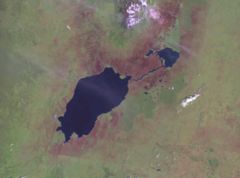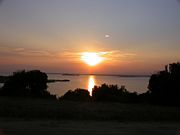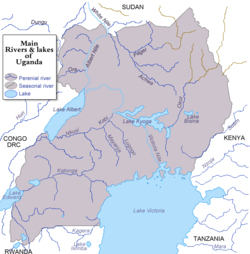Lake Edward
2008/9 Schools Wikipedia Selection. Related subjects: African Geography
| Lake Edward | |
|---|---|
|
|
|
| Coordinates | |
| Lake type | River |
| Primary outflows | Semliki River Kazinga Channel |
| Catchment area | 12,096 km² |
| Basin countries | Democratic Republic of Congo Uganda |
| Max. length | 77 km |
| Max. width | 40 km |
| Surface area | 2,325 km² |
| Average depth | 17m |
| Max. depth | 112m |
| Water volume | 39.5km³ |
| Surface elevation | 912 m |
Lake Edward or Edward Nyanza is the smallest of the Great Lakes of Africa. It is located in the western Great Rift Valley, on the border between the Democratic Republic of the Congo and Uganda, with its northern shore a few kilometers south of the Equator. The lake was named by the explorer Henry Morton Stanley in honour of Prince Albert Edward, The Prince of Wales.
History
Stanley first saw the lake in 1875, and thinking it was part of Lake Albert, named it Beatrice Gulf. On his second visit in 1888 through 1889, he realized that there were two independent lakes, and gave it its current name. In the 1970s and 1980s, Uganda and Zaire (Democratic Republic of the Congo) renamed it Lake Idi Amin or Lake Idi Amin Dada after Ugandan dictator Idi Amin. After his overthrow in 1979, the name was changed back to Lake Edward.
Geography
Topography and drainage
Lake Edward lies at an elevation of 920 metres, is 77 km long by 40 km wide at its maximum points, and covers a total surface area of 2,325 km² (the 15th largest on the continent). The lake is fed by the Nyamugasani, the Ishasha, the Rutshuru, and the Rwindi rivers. It empties to the north via the Semliki River into Lake Albert. Lake George to the northeast empties into Lake Edward via the Kazinga Channel.
The western escarpment of the Great Rift Valley towers up to 2000 m above the western shore of the lake. The southern and eastern shores are flat lava plains. The Ruwenzori Mountains lie 20 km north of the lake.
Volcanism
The region shows much evidence of volcanic activity in the last 5000 years. The Katwe-Kikorongo and Bunyaruguru Volcanic Fields, with extensive cones and craters, lie either side of the Kazinga Channel on the north-west shore of the lake. It is thought that Lakes George and Edward have been joined as one larger lake in the past, but lava from these fields flowed in and divided it, leaving only the Kazinga Channel as the remnant of the past union. To the south, the May-ya-Moto thermally active volcano lies 30 km away, and the Nyamuragira volcano in the western Virunga Mountains lies 80 km south, but its lava flows have reached the lake in the past.
The Katwe-Kikorongo field features dozens of large craters and cones covering an area of 30 km by 15 km between lakes Edward and George, and includes seven crater lakes. The largest of these, the 2.5-kilometre-long Lake Katwe, occupies a crater 4 km across and is separated from Lake Edward by just 300 m of land. The crater is about 100 m deep, and Lake Katwe's surface is about 40 m lower than Lake Edward's. It is remarkable that the volcanic origin of this area south-east of the Ruwenzoris was not known until reported by G. F. Scott Elliot in 1894. Stanley visited Lake Katwe in 1889 and noted the deep depression, the salinity of the lake, and a spring of sulphurous water nearby, but failed to connect this to volcanism.
The similarly-sized Bunyaruguru field on the other side of the Kazinga Channel contains about 30 crater lakes, some larger than Katwe.
Settlements
Lake Edward lies completely within the Virunga National Park (Congo) and the Queen Elizabeth National Park (Uganda) and does not have extensive human habitation on its shores, except at Ishango (DRC) in the north, home to a park ranger training facility. About two-thirds of its waters are in the DR Congo and one third in Uganda. Apart from Ishango, the main Congolese settlement in the south is Vitshumbi, while the Ugandan settlements are Mweya and Katwe in the north-east, near the crater lake of that name, which is the chief producer of salt for Uganda. The Mweya Safari Lodge is the main tourist facility, serving both Lake Edward and Lake Katwe. The nearest cities are Kasese in Uganda to the north-east and Butembo in DR Congo, to the north-west, which are respectively about 50 km and 150 km distant by road.
Ecology
Lake Edward is home to many species of fish, including populations of Bagrus docmac, Sarotherodon niloticus, Sarotherodon leucostictus, and over 50 species of Haplochromis and other haplochromine species, of which only 8 are formally described. Fishing is an important activity among local residents. Fauna living on the banks of the lake – including chimpanzees, elephants, crocodiles, and lions – are protected by the national parks. The area is also home to many perennial and migratory bird species.


